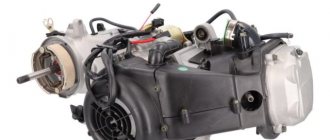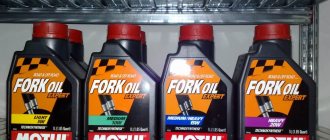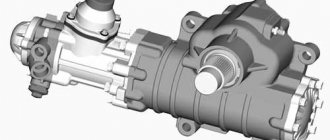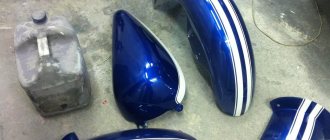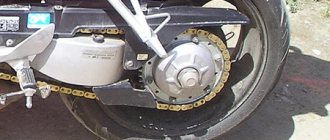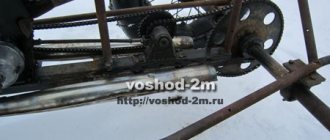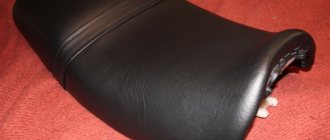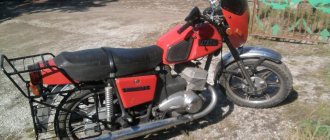Changing the oil in a motorcycle fork is a difficult process for most of all existing models. This procedure makes it possible to extend the life of the shock absorber, so you will be able to maintain good driving characteristics of the motorcycle for a long time. In this article we will not only tell you how to change the oil in the fork, but also share how to choose it correctly.
Oil selection
Choosing fork oil is very difficult, despite the recommendations of motorcycle manufacturers.
The problem is that motorcycle manufacturers often specify ideal viscosity parameters at operating oil temperatures that are many times higher than the temperature at which the fluid is poured into the fork. Therefore, it is necessary to pay attention not only to the standard designation of viscosity, but also to the coefficient of its change with increasing temperature. Such information is often indicated on the canister of liquid, and in its absence, you will need to pay attention to the manufacturer’s website or to specialized materials published by technical experts
Since the characteristics of oils from different manufacturers with the same SAE designation can vary significantly, it is better to choose one brand and remain faithful to it in the future. The first change is always made with oil with the same viscosity as specified in the vehicle’s operating instructions. With a significant reduction in fork stiffness, you will need to gradually increase the viscosity - by 2.5W or 5W with each subsequent replacement, depending on your personal preference. Most touring motorcycles recommend 10W oil, while sport and high-performance city bikes recommend 2.5-5W oil.
It is prohibited to use regular motor oil in the fork as it will help achieve the desired damping characteristics. On a canister with a special material you can find the inscription Fork Oil or Suspension Oil. You should beware of fakes, because with low-quality oil in the fork, the motorcycle can become uncontrollable, which will lead to a serious accident.
When choosing fork stiffness, you need to be guided by the type of roads on which the motorcycle will be used. By adding a thicker oil, you will get better damping characteristics and your vehicle will be more stable at high speeds. However, with an increase in rigidity, comfort will significantly decrease - on any major unevenness the driver will feel a “breakdown”, which can even throw the motorcycle off course. On the contrary, insufficiently viscous fork oil will cause significant vibrations, twitching, or even steering pull when cornering.
If the bike will only be used on quality intercity trails and race tracks, there is nothing wrong with significantly increasing the fork stiffness. However, for driving on country roads and city streets with poor quality coverage, such settings are no longer suitable. A special case is replacing technical fluid in a motocross motorcycle. For it you will have to buy a special technical fluid marked “Off-Road” on the canister. Using regular oil for road motorcycles can significantly reduce the energy capacity of the suspension or even lead to its failure.
Why is this procedure necessary?
The oil in the front shock absorber is changed for a variety of reasons. It has certain functions, and once you understand them, it will become clear why you should change it:
- Provides the necessary rigidity when the suspension is activated on uneven roads;
- Collects metal shavings generated during operation;
- Maintains steering and braking control.
Over time, it draws moisture from the atmosphere (despite the apparent tightness of the structure) and becomes less viscous. This leads to the fact that the vehicle begins to “nod” when braking, may jam, and instability will be especially felt during sharp turns at high speeds, with strong backing.
If the substance accumulates a lot of metal shavings, this provokes rapid wear of the parts, up to the deterioration of the surface of the feathers (and replacing them is a completely different price category for repairs, and it is better not to let this happen).
Replacing the standard plug
The oil change scheme for a standard fork is simple: unscrew the drain plugs, then rinse with kerosene, and only then pour in new oil. But in practice, everything is usually not so simple, because the ease of operation directly depends on the design of the feathers.
Most bikes have bottom drain bolts so you can drain the oil. But on some bikes, manufacturers only thought through the filler holes. Then you will have to disassemble the entire front suspension, since there is no other way to drain the used oil.
Incomplete analysis
Disassembly work must be carried out carefully, as carelessness can stain the entire motorcycle and garage
Rest your front wheel against a secure structure. Work the suspension 20-30 times, this is necessary not only to warm up the oil, but also to ensure that all particles rise. We put the bike on the stand and remove the front wheel. Unscrew the filler bolts, and then unscrew the drain bolts (they can be located at the end of the racks or at the bottom). Then you need to pour 100 milliliters of kerosene or gasoline into the forks, in which case you can remove the metal particles accumulated inside. When the last drops of kerosene and oil have drained, you can add fresh oil; it is important to follow the manufacturer’s recommendations. That is, pour exactly as much oil as the manufacturer of your motorcycle recommends. Next, the bike is assembled in the reverse order.
Complete removal of fork legs
Click on the pendant as many times as possible
This will heat up the oil, and all the particles will be suspended. Remove the wheels and, if necessary, unscrew the dashboard. This will have to be done on many bikes, because this is the only way to gain access to the yoke fasteners. Carefully unscrew the top cover of the pen, being careful not to damage the stand mount. Because they are located close. Next, we loosen the upper and lower crossbars, and then you can remove the feather. Now you can drain the oil and rinse the fork with kerosene. If necessary, oil seals and anthers can be replaced. Assembly is carried out in reverse order.
Why and how often should you change the fork oil?
Oil in a shock-absorbing system has 2 main functions: to absorb metal particles and the role of a damper (to dampen vibrations). As everyone is well aware, oil contaminated with metal particles guarantees accelerated wear of components and parts. And if there is not enough oil in the fork at all, then the motorcycle will begin to seriously “peck”. Not only does this have a negative impact on driving performance, but it can also lead to a serious accident.
In Russia, the oil in a motorcycle fork is changed every 4-6 thousand kilometers. But this is only during active use, that is, in rural areas, in holes and depressions. In urban conditions, the shock absorber does not work so actively, so it is enough to change the oil every 10-12 thousand km.
It is also necessary to urgently change the oil in the following cases:
- After a long period of inactivity during the cold season.
- If there is a lubricant leak.
- During periods of operation established by the bike manufacturer.
Changing the oil of a standard telescopic fork
The general oil change scheme is very simple: unscrew the drain plugs, wait until the oil drains, rinse the fork with kerosene if necessary, and then fill in new oil and put the plugs in place. But alas, practice shows that this procedure primarily depends on the design of the feathers. If the stay has a lower drain bolt, then the front chassis can be serviced without disassembly, but if the fork is of an inverted design or does not have lower drain holes, then you will have to completely disassemble the front suspension structure. Based on this, we divide the oil change process into two types:
Incomplete disassembly of the front suspension: The case is suitable for stays with an end lower or side lower drain bolt. With proper skill, you don’t have to disassemble the suspension at all, but there is always a risk of getting the brake mechanism or wheel dirty with oil, and then you’ll have to do extra cleaning work. It is best to make the replacement as follows: First of all, we clamp the front brake or rest the wheel against the wall, sit on the motorcycle and with the weight of our body force the fork to work 10 - 15 times, this is necessary to warm up the oil, raise sediment and better clean the mechanism. We place the motorcycle on the main stand so that the front wheel is hanging in the air. Remove the front wheel and free access to the upper oil drain bolts from the feathers (the end part of the feather). Using a suitable spanner, unscrew the upper drain bolts (in some cases it may be necessary to loosen the upper clamps). Place a container to collect the oil under the lower drain bolt. Using a spanner wrench, unscrew the bolt and wait until the oil is completely drained. If necessary, rinse the fork with kerosene. We inspect the anthers and seals, replacing them if necessary.
Fill in fresh oil through the top, after tightening the bottom bolt. We tighten the top bolt and mount the wheel and other removed parts.
Note! In this position, after washing or simply draining the oil, some of the liquid remains in the feather and will slightly affect the quality of the mixture. The exception is feathers with a bottom drain plug in the end part
Preparatory work
Although the process of changing the oil is a difficult job, if you approach the matter wisely, you can cope with even such a task. First of all, it is important to prepare everything you need, we will need the following tools:
- Funnel.
- Mallet.
- Kerosene.
- Socket and open-end wrenches.
You still need to prepare an unnecessary container in advance, it could be a 5-liter bottle or an old canister. We will need it to drain the used lubricating fluid. If you don't think about this important detail, you'll simply fill your entire garage with oil.
Symptoms of a motorcycle engine repair are:
- Extraneous noise in the engine
- High oil consumption
- Coolant flow
- Low compression in the engine or large difference between cylinders
- Excessively high compression associated with carbon deposits in the combustion chamber
- Blue smoke from the muffler
- Obvious oil leak from the engine
- Transmission problems
Stages of motorcycle engine repair work:
Disassembling a motorcycle to remove the engine Removing a motorcycle engine Cleaning the engine before disassembling Disassembling the engine Complete troubleshooting of the engine Cleaning the engine of metal shavings and other contaminants Diagnostics of all bearings and gears of the engine Replacement of worn / broken / bent parts Assembling the engine Checking valve clearances Installing the engine on the motorcycle Final motorcycle assembly, launch
All motorcycle engine repair work is carried out by a highly qualified mechanic with extensive experience. A 1 year guarantee is provided for all work performed.
Sequencing
In order to understand what kind of oil to pour into the front fork of a motorcycle, read the manual or instructions for your vehicle. This information is very important because oil can have different densities. Therefore, the denser the oil, the stiffer the fork will behave. A rigid fork transmits more vibration, making movement less comfortable. However, the main advantage is the absence of strong shock and deformation of the fork if you catch a hole at high speed.
It will be necessary to very accurately fill the oil to a certain level. There are two ways to do this correctly:
- When removing the fork, measure the former level - this only works if there are no oil leaks or deformation of the glasses;
- Fill exactly the amount indicated in the manual.
A plug that is too airy or overfilled will not function properly. In the first case, the movement of the motorcycle will fail, in the second, the reaction to unevenness will be too noticeable. It is the oil level that determines the volume of the air gap, which interacts with the road
For expensive and sports motorcycles, it is important to know what kind of oil to pour into the front fork of the motorcycle. It comes in viscosities of 2.5, 3.5 and 7.5 W
It is noteworthy that by mixing two oils of different viscosities, you can obtain a medium viscosity.
Remaining oil is removed by moving the piston up and down. If you see a significant excess of service life based on the color and contamination of the drained oil, you need to wash the internal surfaces with kerosene. Having filled in new oil to the previously determined level, you can begin reassembly.
Important! If you have already disassembled the fork, immediately check all the elements for scuffs and damage. A caring motorcyclist immediately changes all boots and seals to prevent leakage in the future, so immediately take care of the availability of spare parts
Particular attention should be paid to inspecting the bushings, which should secure the fork and not interfere with the operation of the seals. Often, a broken bushing gives freedom to oil seals and anthers, which wear out quickly
An inexperienced motorcycle owner changes boots regularly, but does not eliminate the cause of their wear.
Replacement
When there is no old technical fluid in the lubrication system, you will need to change the oil filter to get rid of the chips or dirt accumulated in it. On some motorcycles it is located on the surface of the motor, while on others you have to remove the plastic lining and protective components to gain access. It is better to remove the oil filter using a special puller or a wrench with a chain, so as not to damage the threads. An emergency option is to pierce the body of the cleaning element with a screwdriver and use it as a lever. However, you need to make sure that the rod does not touch other components of the engine and fuel system.
A little hot oil may spill out of the filter mounting hole, so you should not remove the container for collecting it and gloves yet. A little clean oil is first poured into the new part. It is also necessary to lubricate the rubber O-ring to ensure the tightness of the hydraulic circuit. The filter is twisted until it stops by hand, after which it is pulled out a quarter turn with a wrench. However, you should not show excessive enthusiasm - a broken thread can cause complex, expensive repairs.
After screwing on the filter, reinstall the drain plug and plastic protection. Experts who know how to change the oil on a motorcycle advise to stock up on a funnel in advance that will fit well against the walls of the filler neck. If the diameter differs significantly, some of the lubricant may splash out, which leads to contamination of the vehicle. The filler plug is screwed on as tightly as possible, but you should not be zealous here either. To check the oil level, you need to run the engine for 2-3 minutes and then cool it for 5 minutes.
Lack of oil in a motorcycle engine often causes cylinder scuffing, which requires a major overhaul of the power unit. Therefore, if the level on the dipstick is below the minimum allowable, it is necessary to add the required amount of lubricant, and then repeat the procedure with warming up. Excessive amounts of lubricant also negatively affect the reliability of two-wheeled vehicles - so you should not be lazy to drain the excess if there is any. The most common problems associated with oil overfilling are squeezed out oil seals and seized pistons. Therefore, it is necessary to follow the manufacturer’s instructions, which are indicated in the instructions or on the official website.
Motorcycle clutch repair and replacement
One of the most important mechanisms of motorcycles is the clutch. Although this is a fairly simple structural element, it has an important task. The operation of a motorcycle clutch is based on the frictional force between its discs. The torque of the motor is transmitted to the driven parts, which in turn transmit the torque of the gearbox.
The need for clutch repair in Moscow is dictated by various factors, among which are the intensive use of a motorcycle in the city. In addition, motorcycle clutch repair is in demand in case of planned wear of its individual elements.
Wear of friction linings. Deformation of damper springs. Malfunction of the clutch basket splines.
Replacing motorcycle clutch friction discs. Repair or replacement of the clutch machine. Replacing or servicing the clutch cable Replacing and adjusting the clutch lever
Useful tips
If the brake discs are stained with oil during operation, they must be treated with alcohol. After all procedures, check the functionality of the mechanism. If it starts to “peck” - air pockets appear - there is not enough oil. Too much oil was poured into the steering wheel when there is strong kickback
Be sure to pay attention to the condition of the plug. Here is a list of fork maintenance: smudges - inspection of oil seals and anthers; incorrect operation - checking the spring and mechanism geometry; simple – complete revision; suitable mileage - mandatory flushing and oil change
Flushing is best done with low-viscosity oil. Despite the fact that the seals are able to withstand the effects of kerosene and other flushing liquids, they still become tanned and fail faster.
Complete removal of fork legs
If you need to carry out not only an oil change, but also a high-quality flush, an inspection of the insides of the pen, or if there is no lower drain hole, then the pen is removed completely. The whole process looks like this: Warming up the oil in the fork (with the brake pressed, we force the fork to operate as much as possible). We remove the wheel, front fender and, if necessary, part of the dashboard, freeing the passage to the traverse fasteners. We twist the top cap of the pen without unscrewing the bottom (if any). We loosen the upper and lower traverses by removing the feather; if it does not give in, tap it with a mallet or unscrew the bolts further. We prepare a container for draining the oil, unscrew the drain bolt and drain all the lubricant, helping to compress and unclench the fork.
Important! When draining the oil through the top plug, the spring and bushings may fall out of the fork; carefully remove them to the side, observing the removal order.
We wash the fork, inspect the anthers and seals, replacing them if necessary. We install the parts removed from the pen in the reverse order and fill in the appropriate oil, its volume is indicated in the accompanying documentation and carry out the entire procedure for the other pen. We reassemble everything in the reverse order, carefully controlling the tightness of all bolts.
Oil selection
Looking ahead, it should be noted that it is best to give the choice of oil to the manufacturer. The problem is that choosing the right oil is quite difficult, because its viscosity is selected taking into account a specific design, its spring and a number of other parameters, for example, the preservation or change of astringent properties when heated. Yes, the fork heats up during riding, along with the oil, which changes its characteristics. If the manufacturer has not indicated the exact brand of oil, then we select it based on viscosity from 10 to 2.5 W, depending on the type of motorcycle.
Regular motor oil is not suitable, we should choose Fork or Suspension Oil. Do not forget that the market is filled with fakes and their use can lead to unpleasant consequences in the form of an accident. The volume of oil should also be indicated by the manufacturer; this is approximately 400 ml of liquid in each pen. The indicator may vary from model to model. If you do not find accurate data, then you can fill in the liquid by analogy with the volume of drained material; if there were leaks, then refilling can be done through the upper drain bolt. More experienced riders can adjust fork stiffness primarily by using different viscosity oils. For example, pouring thinner oil can soften the suspension and make it more comfortable to move over rough terrain. For country trips, you should fill in oil with a higher viscosity. The fork will become more elastic and the motorcycle will stay on the road better, especially at high speeds. The main thing is not to forget that the deviation of the selected oil from the recommended one should be insignificant, and it is also worth taking into account the change in its properties when heated.
Responsible process
The controllability of the motorcycle, and, consequently, the safety of the driver and others depends on the correct selection of oil for the fork. It is best to follow the recommendations of the motorcycle manufacturer, but increase the viscosity of the technical fluid when components wear in order to achieve good damping characteristics. It is also worth paying attention to the oil change procedure - the ability to adjust the suspension and obtain optimal rigidity depends on its correct implementation. We must not forget about flushing the fork after draining the old oil - drops of technical fluid remaining inside and chips obtained from friction between the components can significantly affect the characteristics of the shock absorbers. If you are not sure that you can perform an oil change and suspension adjustment yourself, contact professional mechanics, since your interventions can only cause harm.
Working conditions of a motorcycle shock absorber fork
The front fork is two long tubular pieces that hold the front wheel to the motorcycle. These parts move up and down to compensate for unevenness in the road surface.
Unlike a car shock absorber, the spring assembly allows the fork leg to compress and then spring back, resulting in a better ride and improved traction. Each of the front fork tubes for most motorcycles contains a spring and oil. Back in the middle of the last century, fork legs were just a spring inside a pipe. When the spring was compressed by the impacts, the front of the motorcycle bounced.
After the development of the damping system, this bouncing motion became much smoother. However, to soften shock impacts, the system must contain an incompressible fluid that can easily withstand shock loads - fork oil. The most common design is one where inside each shock absorber fork leg there is a tube with holes and chambers that control the movement of oil.
Functions and Features
Despite the wide range of products offered, there are many discrepancies and uncertainties in their designation and parameters. Thus, the operational requirements for fork oils include:
- Ensuring optimal fork damping and stable performance over a wide temperature range.
- Independence of oil performance from fork design.
- Prevents foaming.
- Elimination of corrosive effects on metal parts of the shock absorber and fork.
- Chemical inertness of the composition.
All brands of fork oils for motorcycles are hydraulic fluids, and therefore even some general purpose industrial oils in accordance with GOST 20799-88 with a suitable viscosity can be used. Note that with increasing oil viscosity, the fork will return to its original position more slowly. On the other hand, with increasing viscosity, the performance of the oil increases, especially when driving on bad roads, for motocross motorcycles.
How to check whether the engine was repaired by the previous owner
If you buy a motorcycle secondhand, it is worth checking it for any repairs. Perhaps it was not produced professionally, or even the symptoms were simply removed. In any case, you may have problems with further operation.
First of all, inspect the engine yourself. If the bolts on the parts are visually different, then the motor has been disassembled. Also, if there is no dirt and dust, this may indicate a recent engine overhaul. Although the latter may simply be a sign of a good attitude towards technology.
If in any doubt, take your motorcycle to a motorcycle restoration specialist. He will be able to accurately determine whether the unit has been repaired.
Start of renovation
Before starting repairs, place the motorcycle on a comfortable and reliable stand, so that the front wheel is free. Next you will need to remove the wheel and disconnect it from the brake mechanism. In some cases, it is also necessary to remove the wing or rudder.
You should start by “undermining” the plugs of the feathers. Not by unscrewing, but by changing the position of the cover by a quarter turn. Corks are always made with decorative processing or chrome plated. If you don’t have a reliable and clearly sized key on hand, you shouldn’t injure the plugs.
A slight slippage or licking of the edges will immediately ruin the attractive appearance. Some craftsmen use fabric or thin rubber as a gasket. This method cannot prevent the appearance of scratches, even if you try very hard.
A closed plug will not only protect the cylinders from dirt, but will also prevent injury from a fired, tense steel spring. After loosening the traverse bolts, you need to smoothly remove the fork. Before this procedure, you should have a container prepared to remove used oil from the fork. Turn the fork over and drain the oil from the feathers. Judging by the color and consistency, it becomes clear why the fork was cottony or too hard.
How to choose fork oil?
First of all, by its viscosity. As is known, kinematic viscosity is measured in centistokes (cSt), and represents the speed of fluid flow through a conventional tube of a certain cross-section. In practice, the dimension mm2/s is more often used. In relation to fork oils, the standards of the American Society of Automotive Engineering (SAE) apply, which relate viscosity values at a certain temperature (usually 40 °C) to the density and weight of the product. Weight in English weight; From the initial letter of this word the designations of fork oil brands are formed. So, when considering fork oils for motorcycles of brands 5W, 10W, 15 W, 20W and so on, you should remember that, for example, 10W class oil corresponds to a product with a nominal viscosity of about 10 mm2/s.
Fork oil weight is determined by an industry standard for hydraulic systems called Saybolt Seconds Universal (SSU). Unfortunately, the voluntarism of the main manufacturers often leads to confusion among the labeling of fork oils. The following correspondence of viscosity parameters was experimentally established:
| Marking | Actual viscosity value, mm2/s at 40 °C, according to ASTM D 445 for brand products | |||
| RockShox | Liqui Moly | Motul | Motorex Racing Fork Oil | |
| 5W | 16,1 | 17,2 | 18 | 15,2 |
| 10W | 33 | 29,6 | 36 | 32 |
| 15W | 43,8 | 43,9 | 57 | 46 |
| 20W | — | — | 77,9 | 68 |
Dismantling the Ural motorcycle engine
Repair of a Ural motorcycle should be carried out in stages. The first step is to prepare your garage and the engine itself. All dirt and oil must be washed off the engine so that they do not get inside. Laying a film on the floor will help protect the garage floor, because it is easier to throw away a piece of cellophane than to remove the remaining grease from the garage floor. Disassembly process:
- Unscrew the nuts holding the cylinder cover and remove it. Next, unscrew the nuts securing the cylinder head, put the rocker arms and rods into the box and pull the head off the studs.
- Remove the cylinder mounting nuts and, shaking, carefully remove the cylinder from the studs.
- We remove the retaining rings and press out the piston pin with a special puller.
- Unscrew the screws securing the gas distribution mechanism and remove the crankcase cover.
- Unscrew the camshaft flange, remove the plug in the upper part of the crankcase and the oil pump drive.
- Using mounting blades, remove the camshaft.
- We bend the lock washer and then unscrew the screw securing the gear on the crankshaft journal. Using mounting blades, remove the drive gear.
- Unscrew the screws of the upper clutch disc.
- We mark the disks in the position they were in.
- Remove the bolt securing the flywheel to the crankshaft.
- Remove the flywheel from the conical part of the shaft.
- Remove the bolts from the rear main bearing housing.
- We remove the engine sump, and with it the filter and oil pump.
- We press the crankshaft out of the front bearing and remove it from the crankcase.
Following this diagram, you will be able to get to the main parts of the engine in order to conduct a full diagnostic of the gaps and, if necessary, replace the parts with new ones. It is worth noting that if a part has a gap close to wear, then it is better to replace it, since most new spare parts lead to increased load on the entire engine while it is running in. Such increased pressure on old components can lead to their wear, which means the appearance of noise.
